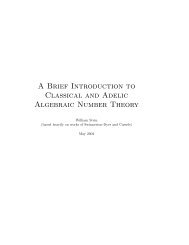A Short Course on Galois Cohomology - William Stein - University of ...
A Short Course on Galois Cohomology - William Stein - University of ...
A Short Course on Galois Cohomology - William Stein - University of ...
You also want an ePaper? Increase the reach of your titles
YUMPU automatically turns print PDFs into web optimized ePapers that Google loves.
is an isomorphism. Reducing modulo v we have an exact sequence<br />
0 → A 0 k → Ak → ΦA,v → 0, (20.1)<br />
where A0 k is the c<strong>on</strong>nected comp<strong>on</strong>ent that c<strong>on</strong>tains the identity and ΦA,v<br />
is a finite flat group scheme over k, called the comp<strong>on</strong>ent group <strong>of</strong> A at v.<br />
Propositi<strong>on</strong> 20.9. For every integer q, we have<br />
ˆH q (k, Ak) = ˆ H q (k, ΦA,v).<br />
Pro<strong>of</strong>. Take <strong>Galois</strong> cohomology associated to the exact sequence (20.1), and<br />
use Corollary 20.7.<br />
21 Duality<br />
WARNING: For the rest <strong>of</strong> this book, we’re going to let ¯ k denote a separable<br />
closure <strong>of</strong> k, since it’s much easier notati<strong>on</strong> to work with (I’ll go back<br />
and change the notati<strong>on</strong> above later).<br />
Let k be a field and ¯ k a choice <strong>of</strong> separable closure <strong>of</strong> k.<br />
21.1 Duality over a Local Field<br />
Let M be any Gk = Gal( ¯ k/k)-module and set<br />
ˆM = Hom(M, ¯ k ∗ ),<br />
which we give the structure <strong>of</strong> (left) Gk-module by<br />
(g.ϕ)(a) = g(ϕ(g −1 a)).<br />
To see that this gives ˆ M a Gk-module structure, note that if g, h ∈ GK,<br />
then<br />
((gh).ϕ)(a) = (gh)(ϕ((gh) −1 a)) = (gh)(ϕ(h −1 g −1 a))<br />
and<br />
(g.(h.ϕ))(a) = g((h.ϕ)(g −1 a)) = g(h(ϕ(h −1 g −1 a))).<br />
Theorem 21.1 (Tate Local Duality). Let k be a local field and M a finite<br />
Gk-module <strong>of</strong> order coprime to the characteristic <strong>of</strong> k. Then for r = 0, 1, 2,<br />
the cup product pairing<br />
H r (k, M) × H 2−r (k, ˆ M) → H 2 (k, ¯ k ∗ ) ∼ = Q/Z<br />
is n<strong>on</strong>degenerate. Also H q (k, M) = 0 for q ≥ 3.<br />
The pro<strong>of</strong> <strong>of</strong> this theorem is bey<strong>on</strong>d the scope <strong>of</strong> this course, since it<br />
requires developing too much general machinery. See [Ser97] for complete<br />
details.<br />
46
















